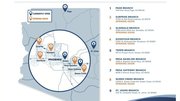News
UK's independent operators bear brunt of ire over ATM fees
In the wake of a showdown over surcharging in the United Kingdom, editor Ann All wonders whether there might be room for increased cooperation among the UK's ATM operators -- to the benefit of all.
February 7, 2005
Independent ATM deployers have emerged as the favorite whipping boys of British politicians and press, in a showdown over surcharging in the United Kingdom. The story, already an ugly one, is getting uglier by the minute.
A headline in a recent edition of the Sunday Mail (admittedly not a publication noted for its understated coverage) read "Cashpoint rip-off: Hole in the wall gang's �8M heist." The article noted that more than 1,500 of the 4,500 ATMs in Scotland assess a user fee -- amounting to �8 million (U.S. $14.8 million) a year in withdrawals.
British MPs have been conducting a series of hearings on the issue of fee-charging ATMs, with several MPs calling for an Office of Fair Trading investigation. The MPs contend that a large number of the machines are located in rural and underprivileged areas where users can ill afford the fees.
 |
Ann All |
Indeed, there is some truth to this -- it often isn't possible for ATM operators to turn a profit in remote locations without collecting a user fee.
It costs more to dispatch cash-in-transit companies and other service providers to those areas. Compounding the problem, the machines typically generate low transaction volumes.
Because of losses it was incurring at some sites, a large financial institution -- HBOS -- sold some 800 of its non-branch ATMs to Cardpoint, a leading independent operator, which promptly began collecting a fee at 250 of them. HBOS Chief Executive James Crosby called the machines "underperforming and unsustainable."
Logical move
It seems unrealistic to expect banks to eat their losses and offer ATMs as a public service. Selling off unprofitable sites seems like a logical business move to me -- especially if cardholders have other options for getting money such as cashback at the point-of-sale.
Much like the United States, deployment of non-bank ATMs in the UK has outpaced the number of bank-owned machines in recent years. Banks, with their higher overheads, are often unable to turn a profit at sites where independents can -- through a combination of watching their costs closely and collecting user fees.
According to Nationwide building society, a surcharge foe, the number of fee-charging ATMs in the UK grew by 29 percent in the first seven months of 2004; during the same period, the number of free machines grew just 0.3 percent.
In several published reports, much has been made of the fact that Mark Mills, Cardpoint's CEO, collected a �150,000 (U.S. $278,450) bonus for architecting the HBOS deal, and that HBOS loaned Cardpoint some of the �50 million (U.S. $92.8 million) it used to purchase the ATMs.
Frankly, it's hard for me to find anything sinister in either fact. It's common for executives to receive hefty bonuses for lucrative deals, and Cardpoint has been a commercial client of HBOS' for several years.
Several reports also cited Royal Bank of Scotland's purchase of Hanco ATM Systems, another leading independent ATM operator, and its 5,000 ATM contracts. It's unclear how Royal Bank intends to leverage the Hanco acquisition, which is currently operating as a subsidiary.
Interestingly, the financial stock of Australia's Bank of Queensland has been on the rise since its decision to expand its non-branch ATM network by purchasing independent provider ATM Solutions Australasia in 2003. Earlier this week, BOQ announced the purchase of 116 ATM contracts from another independent, Autocash Systems.
Growth is good
The number of ATMs in the UK has more than doubled in the past five years, since Link, the country's national ATM network, began admitting independents like Hanco and Cardpoint into its ranks.
Some 20,000, or about 40 percent of the UK's total 54,000 ATMs, assess user fees. Many of them are at "convenience" locations where the service wouldn't be possible without a surcharge.
Nationwide led the campaign against surcharging in late 1999 when another financial institution, Barclays, announced plans to introduce surcharging at its ATMs. The result was that Link members agreed that acquirers could collect either a surcharge or interchange -- but not both -- for ATM transactions.
Since then, most FIs -- with a few notable exceptions such as Alliance & Leicester -- have opted to collect interchange, which is invisible to the public. Independents generally assess surcharges.
Know before you go
Nationwide was at the center of another surcharge flap in the summer of 2003, when it contended that consumers were not always aware that they were paying a user fee -- even when it was disclosed on the ATM screen during transactions. Link then introduced a policy requiring members to disclose any charges before ATM users inserted their cards.
Since then, UK ATM operators have placed stickers warning of fees on their machines.
Cardpoint's Mills, however, faced a harsh rebuke from MP James Plaskitt during the Treasury hearings, when Plaskitt produced a photo a Cardpoint machine where the warning was at knee-level. "For three years you've been happy to warn people's knees," Plaskitt told Mills.
It certainly seems reasonable to standardize warning messages required at ATMs. Many United States networks require disclosures in three places: on the outside of the ATM, on-screen during the transaction and on the receipt.
A Star survey conducted in 2003 found that 92 percent of consumers said they were adequately informed of surcharges; 19 percent saw a disclosure on the ATM, 53 percent saw one on screen before the transaction began, and 28 percent saw it during the transaction.
Establishing a cap for surcharges is another idea that has been floated in the British press. While this doesn't seem unreasonable on its face, I can think of few other instances in the free market where caps are imposed on consumer services.
Look at Starbucks. Before the growth of the wildly successful chain, few people probably could envision themselves paying $5 for a simple cup of coffee. Yet millions of us do it every day -- or once a week, or once a month, or whenever the craving for a mocha latte strikes us.
Business of branding
I wonder whether there isn't room for some cooperation among FIs and independent operators? Here in the States, a growing number of FIs are outsourcing the operation of all or part of their ATM fleets to independents.
Still others are purchasing branding rights on retail machines managed by independents. For a fee -- typically based on card bases, transaction volumes and/or other factors -- the FI gets to place its brand on the ATM and offer surcharge-free access to its cardholders. All other cardholders pay a user fee; the FI may or may not receive a cut of those revenues.
Such deals benefit the FIs, who get to offer their customers a service for far less than the cost of deploying their own machines. Independents gain a fixed revenue stream to help protect them from shrinking transaction volumes. Transactions -- both on-us and off-us -- also typically increase with the addition of a bank brand. Merchants owning stores where ATMs are located obviously appreciate the added traffic.














